KIC8462852 Hereford Arizona Observatory
Photometry Observations #3
Bruce Gary, Last updated: 2017.09.28, 05 UT
I've switched from V-band to g'-band, starting Sep 21. The
g'-band observations can be found at http://www.brucegary.net/ts4/
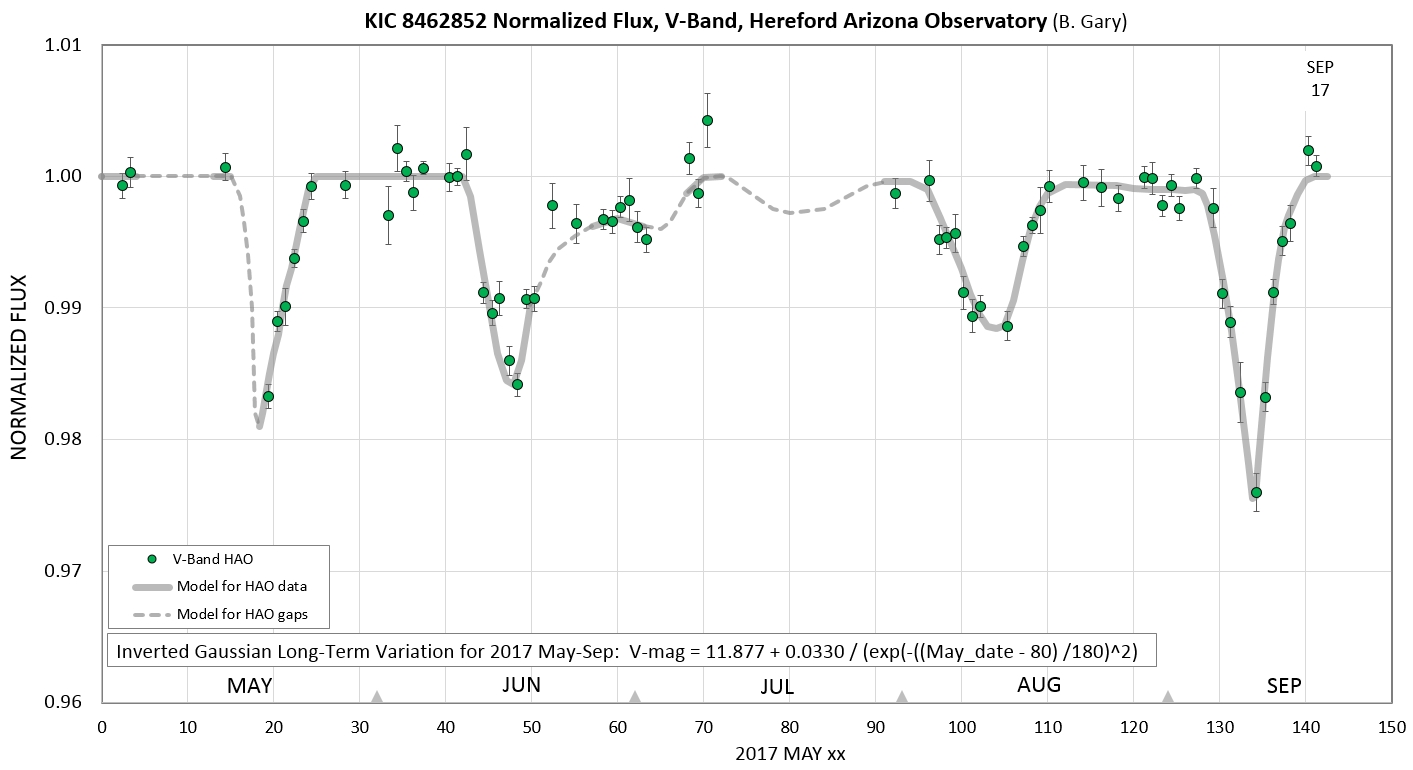
Figure 1.1a. Light curve for "May
to now" for HAO V-band observations, with an adjustment for an
"Inverse Gaussian" model for the long-term variation/fade of OOT
brightness (described below). Starting Sep 18 there's an unknown
offset due to a change of configuration.
Notice the different
asymmetries for the three major fade events: the May fade begins
fast and recovers slower, the June fade begins slower and its
recovery is interrupted by a small fade, while the August fade
began slowly and recovered fast. None of these shapes resemble
exo-comet tail transits (as described by Rappaport et al, 2017 link); so the
mystery of what's producing these week-timescale dips continues!
The current dip is "in recovery." even the detailed
observations (15-minute averages) show the increasing brightness
during the past two nights (see next two figures).
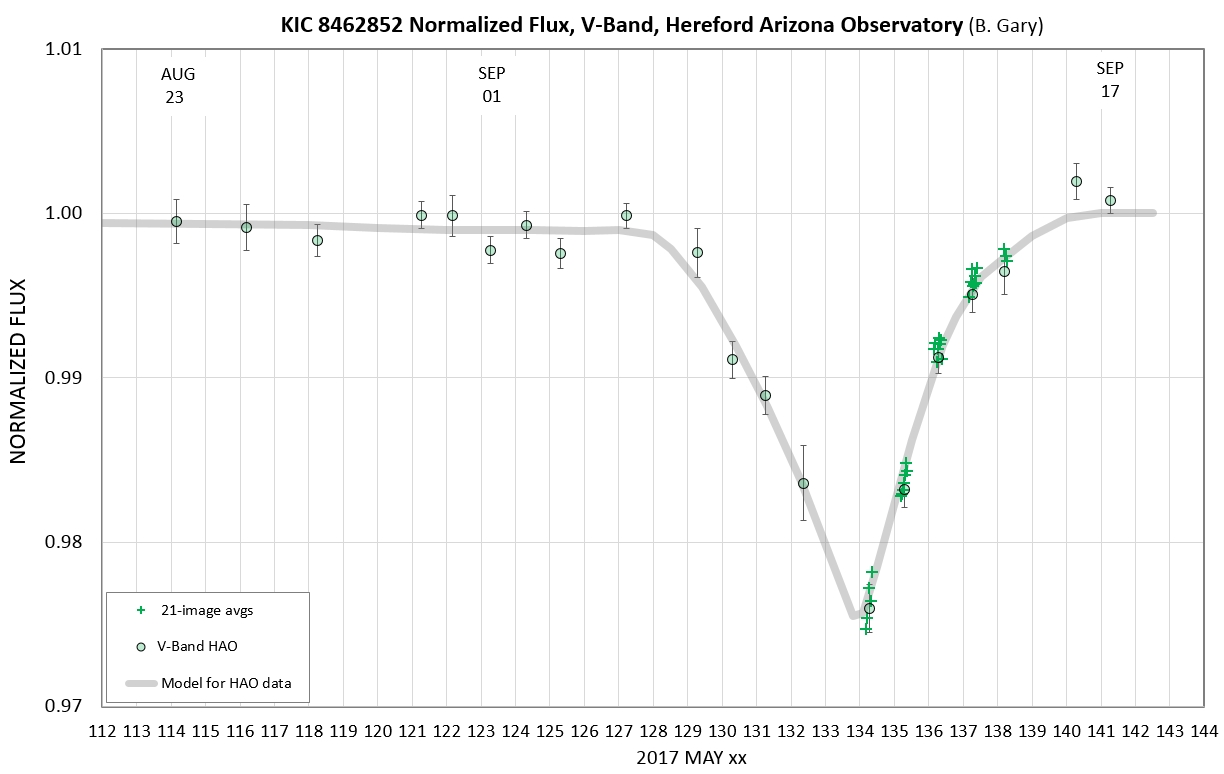
Figure 1.1b. Detail showing "shape" of the latest
dip, and 45-minute
averages for last two days. It has a "negative
curvature" (of normalized flux) on the ingress; let's see what
the curvature is for egress. Note: a comet pass would produce an
opposite pattern of curvatures (positive for ingress and
negative curvature for egress), so already this doesn't look
like a comet tail transit. The Sep 11 45-minute averages exhibit
an RMS scatter of 0.00028 (i.e., 0.28 mmag), which is my
all-time best performance for me. Don't believe the Spe 18 data.
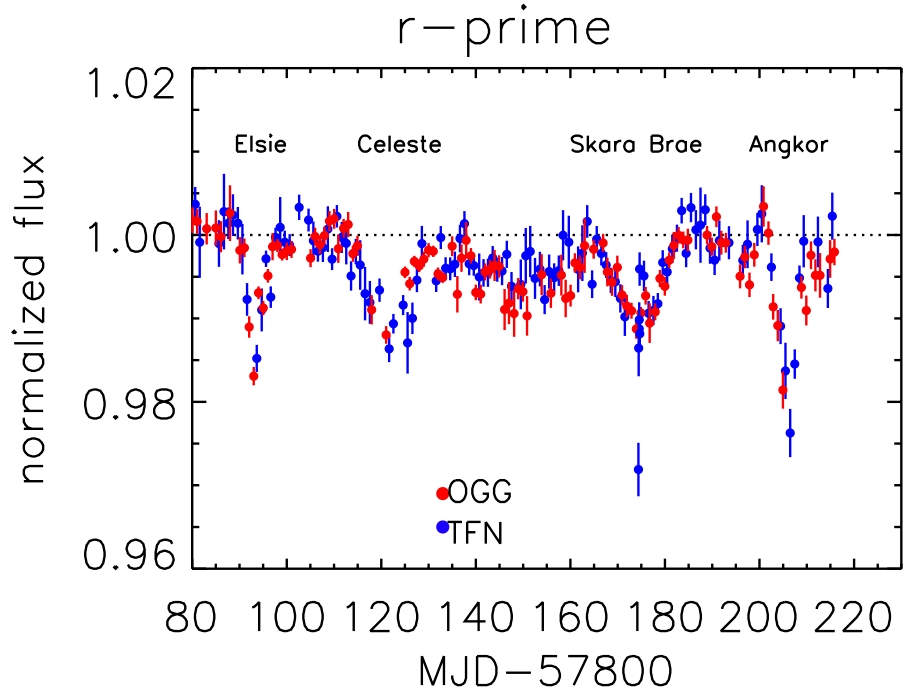
Figure 1.2. Tabby Team r'-band LC. Last data is for Sep
18.
Tabby's Star undergoes
variations on many timescales. The ASAS and ASAS-SN V-band
observations reported by Simon et al. (2017) illustrate
the presence of multi-year and multi-month variations, and the
Kepler data, plus recent ground-based data, show multi-day
variations (dips). If one category of variation is to be studied
in isolation of the others some method must be devised for
modeling the other variations. For example, for the study of
multi-day dips it is necessary to model the multi-month and
multi-year variations. This process is inherently subjective,
both in the timescale to be represented by the model and the
model chosen for that purpose. The next graph shows Tabby Star
V-mag the last 4 months, and I used the inverted Gaussian model
with parameter values chosen to fit just the past 4 months of
OOT data. Identifying OOT data when dips are present is also
somewhat subjective. Finally, I have used a subjective process
for correcting Tabby Star magnitudes for small linear drifts in
reference star brightness (as will be described in another
section).
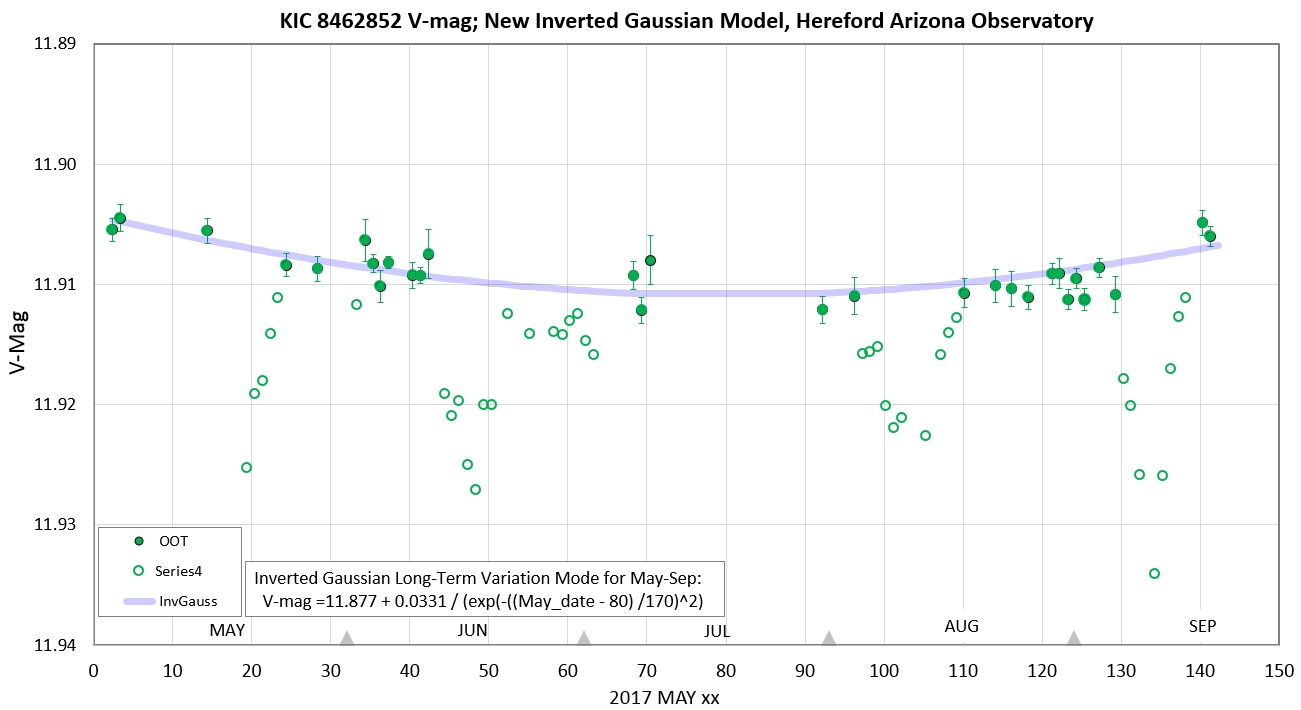
Figure 1.3. Tabby Star V-magnitudes after removal of small
systematics based on behavior of 21 reference stars. The
inverse Gaussian model parameter values were chosen for
fitting just this 4-month span of data.
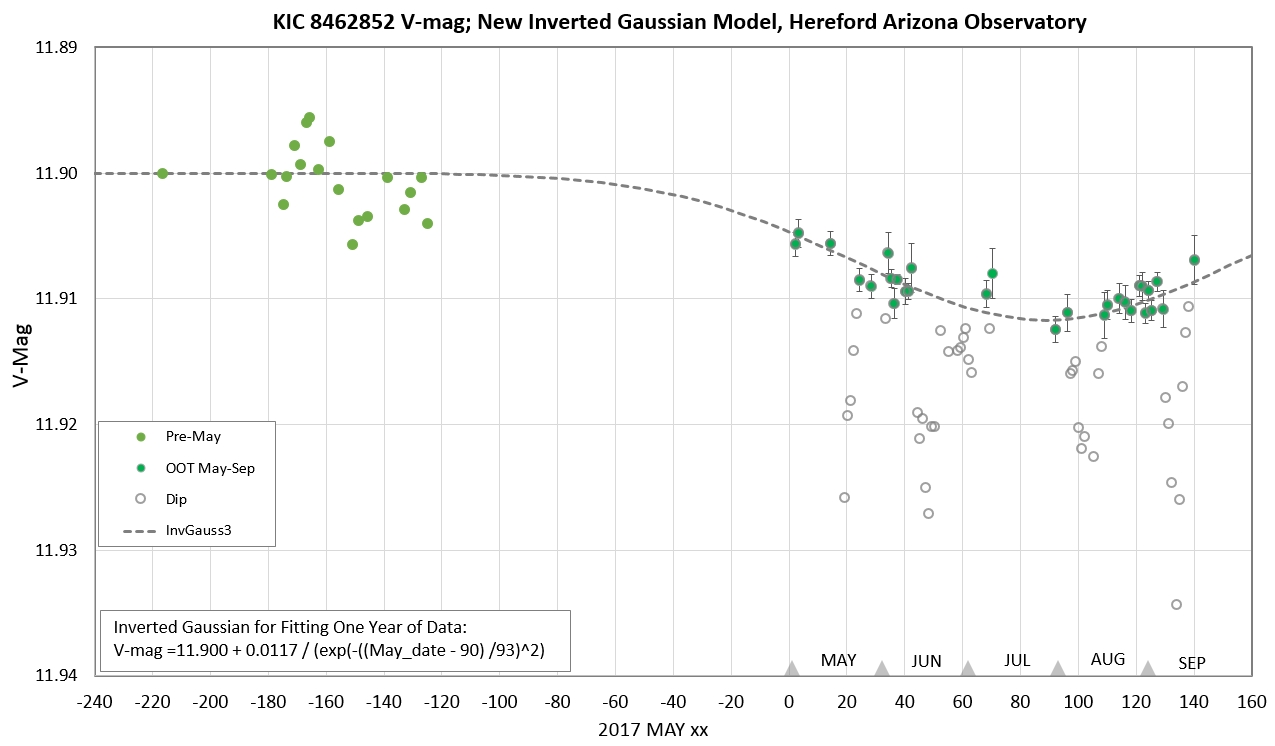
Figure 1.4. V-magnitude measurements after removing
small reference star systematics. Reference star trends have
been used to adjust TS magnitudes.
Links on this web page
History of why this web page
List of observing sessions
A prediction
References
Go back to 2nd of three web
pages (for dates 2014.05.02 to 2017.08.28)
Go back to 1st
of three web pages (for dates 2017.06.18 to
2017.06.17)
Reference
Star Quality Assessment (the 10 best stars out of 25
evaluated)
History of this web page
This is
the third of three web pages devoted to my observations of Tabby's
Star. One reason for splitting the pages is that when a page has a
lot of images the download time becomes excessive. But the real
reason for this page splitting is to avoid the attention of people
who post things on Reddit, "the paparazzi of the internet" (a
place meant for Roobs).
List of
Observations (for all
earlier observations, before Aug 29, go to link)
2017.09.18 V
2017.09.17 V
2017.09.16 V
2017.09.14 V
2017.09.13 V
2017.09.12 V
2017.09.11 V
2017.09.10 V
2017.09.08 V
2017.09.07 V
2017.09.06 V
2017.09.05 V
2017.09.03 V
2017.09.01 V
2017.08.31 V
2017.08.30 V
2017.08.29 V
Daily Observing
Session Information (most
recent at top)
2017.09.18, V-band, 2.5 hrs
Configuration change: removed focal reducer. Image scale changed
from 1.70 "arc/px (binned 2x2) to 0.83 "arc/px (binned 2x2).
Smller FOV, new flat fields.
Because of the new configuration the systematics may have changed,
so don't take any differences from the past seriously! It appears
that there's a 7 mmag (0.7%) systematic difference in V-mag for
the new configuration.
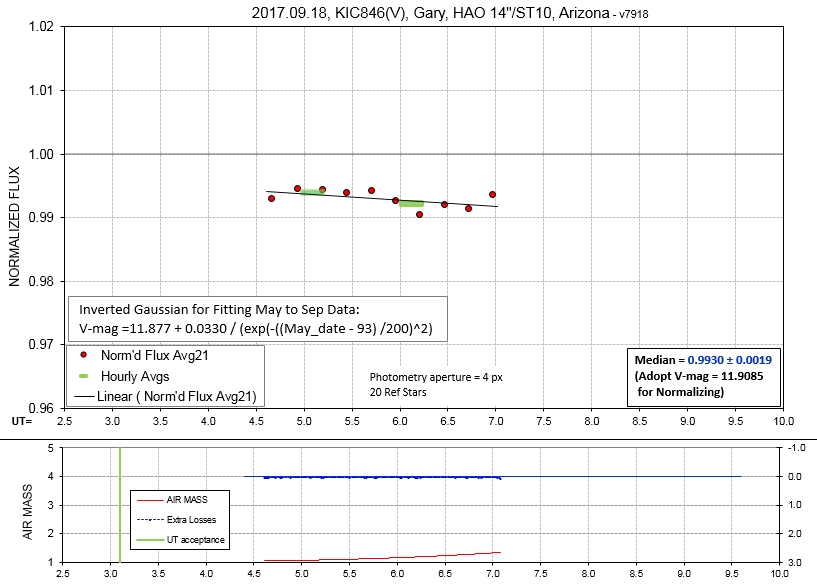
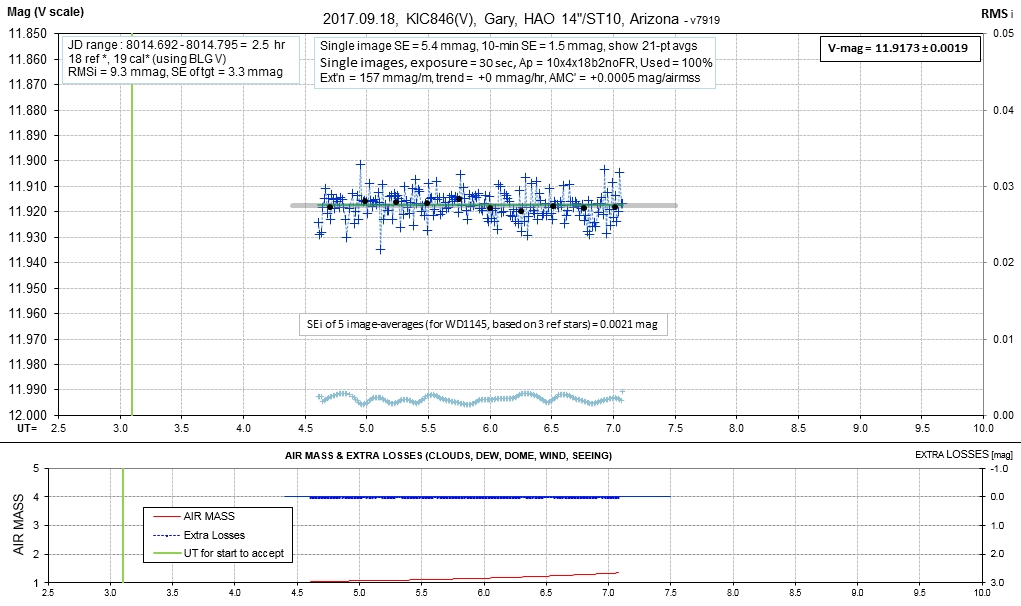
2017.09.17, V-band, 4.5 hrs
DataExchangeFile
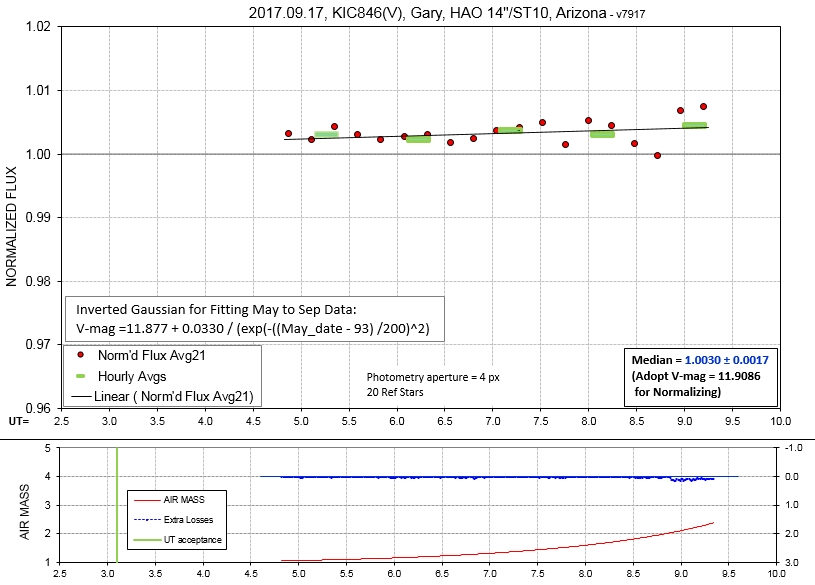

2017.09.16, V-band, 5.1 hrs DataExchangeFile
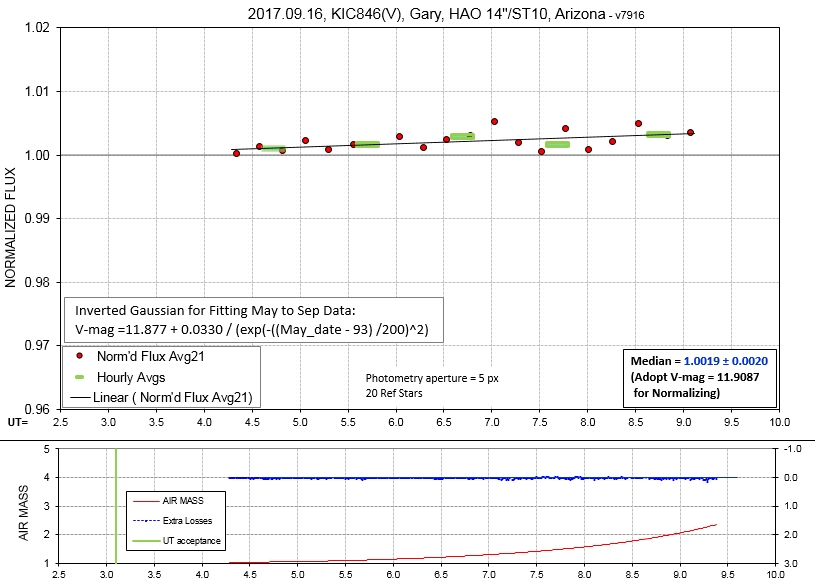
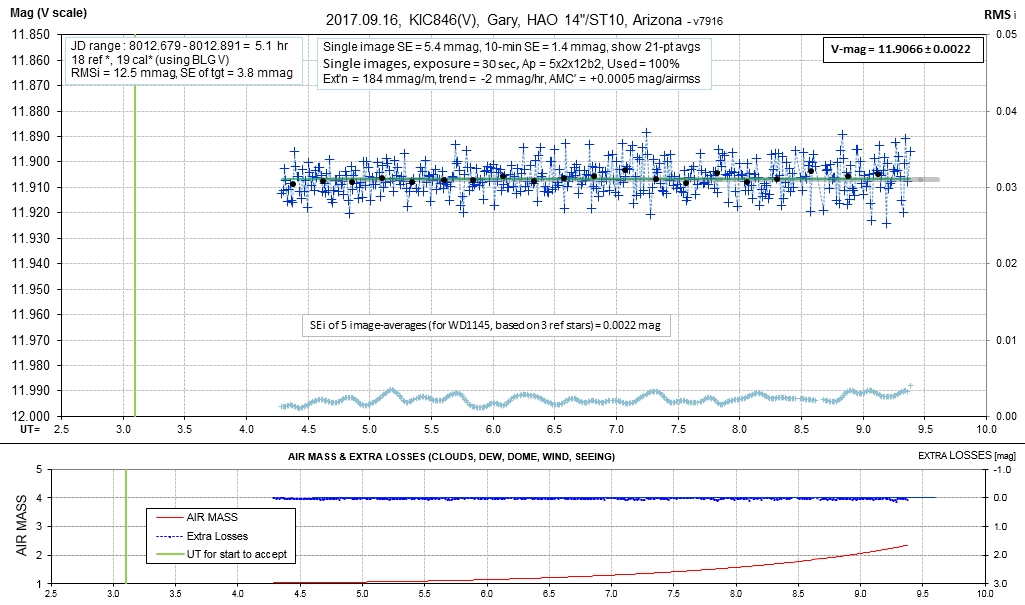
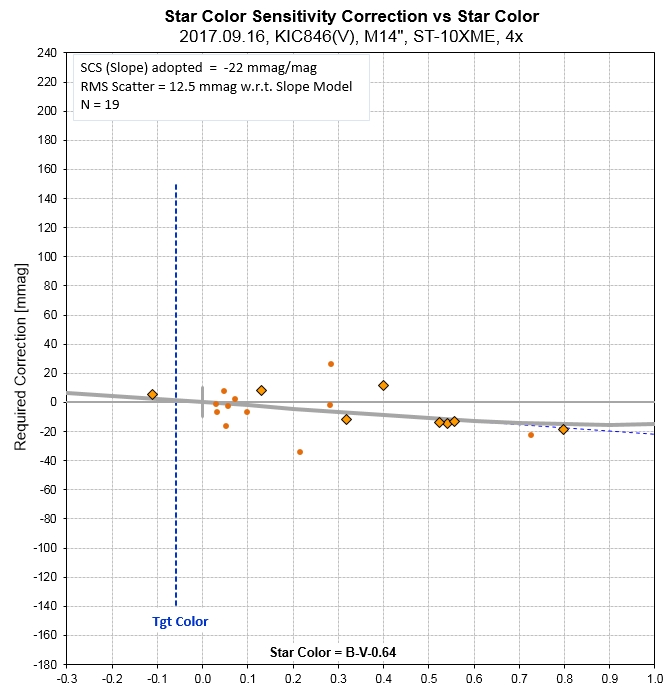
2017.09.14, V-band, 3.1hrs DataExchangeFile
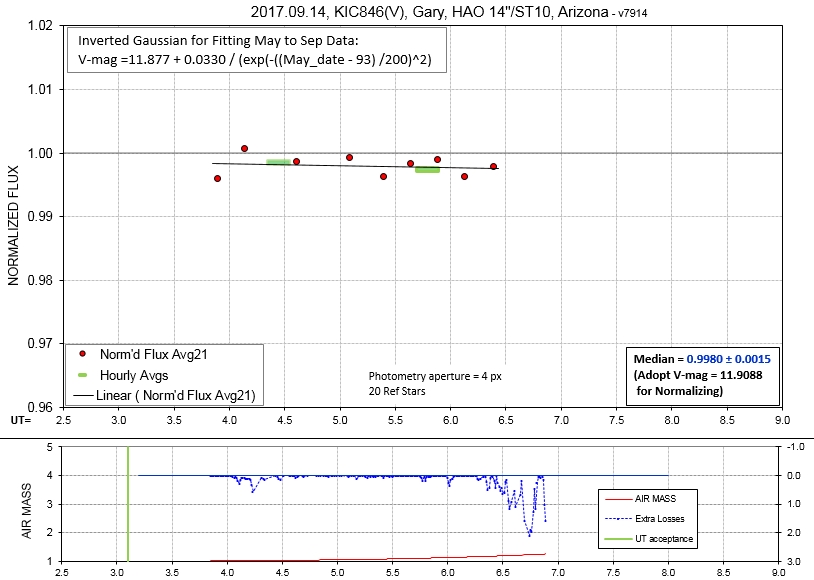
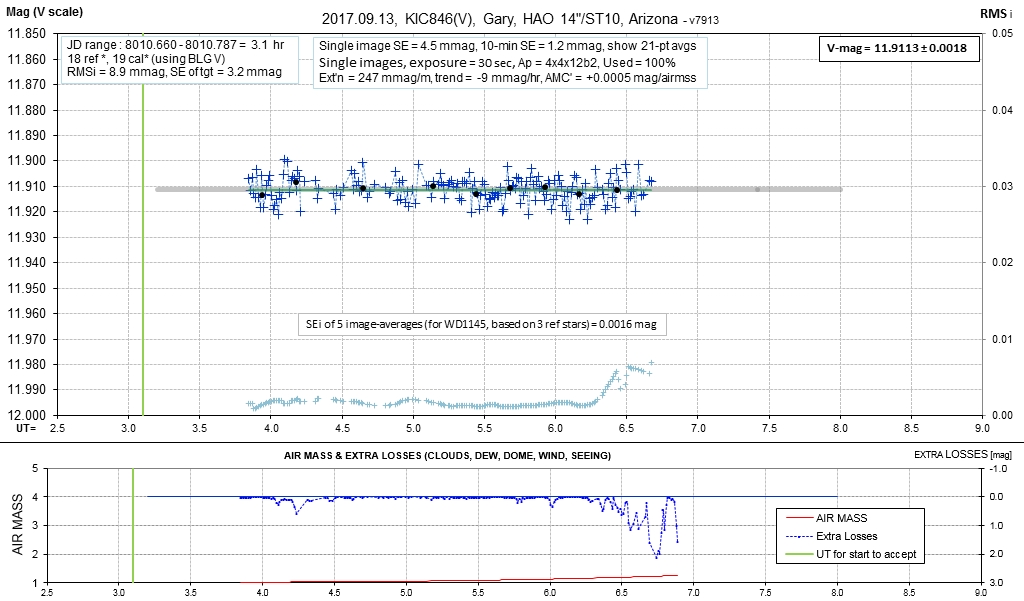
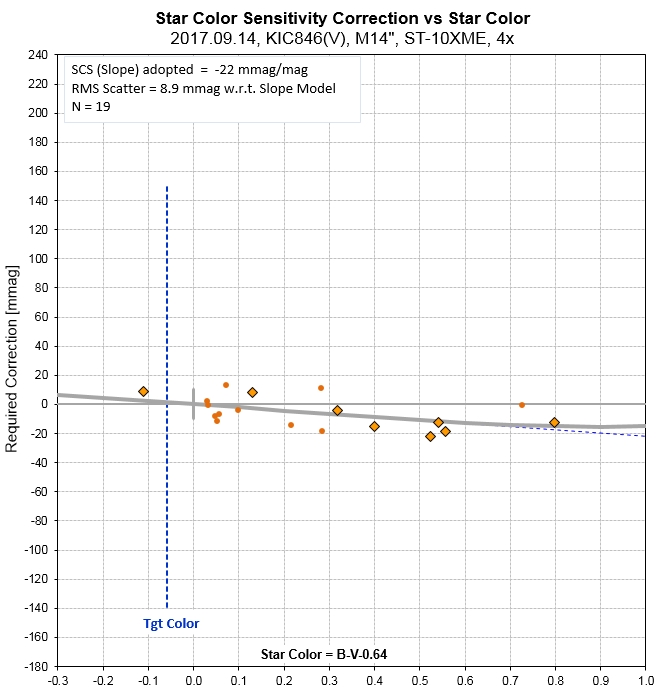
2017.09.13, V-band, 5.7 hrs DataExchangeFile
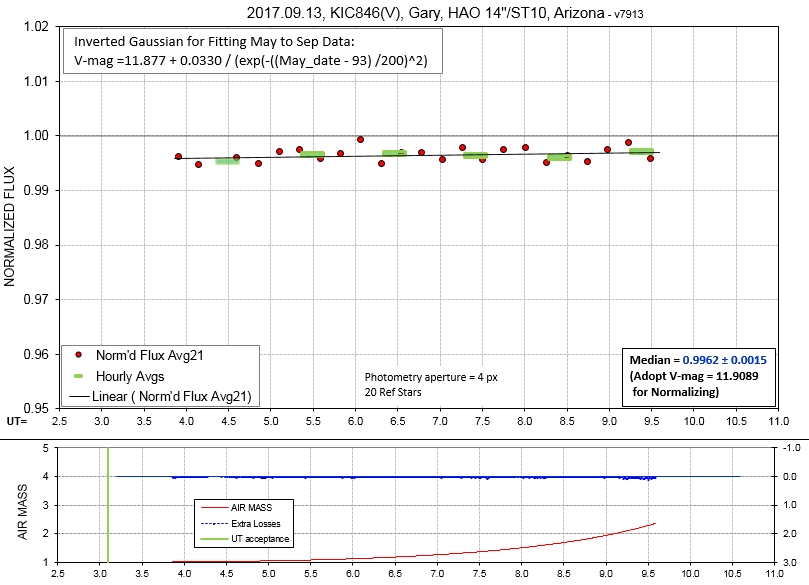
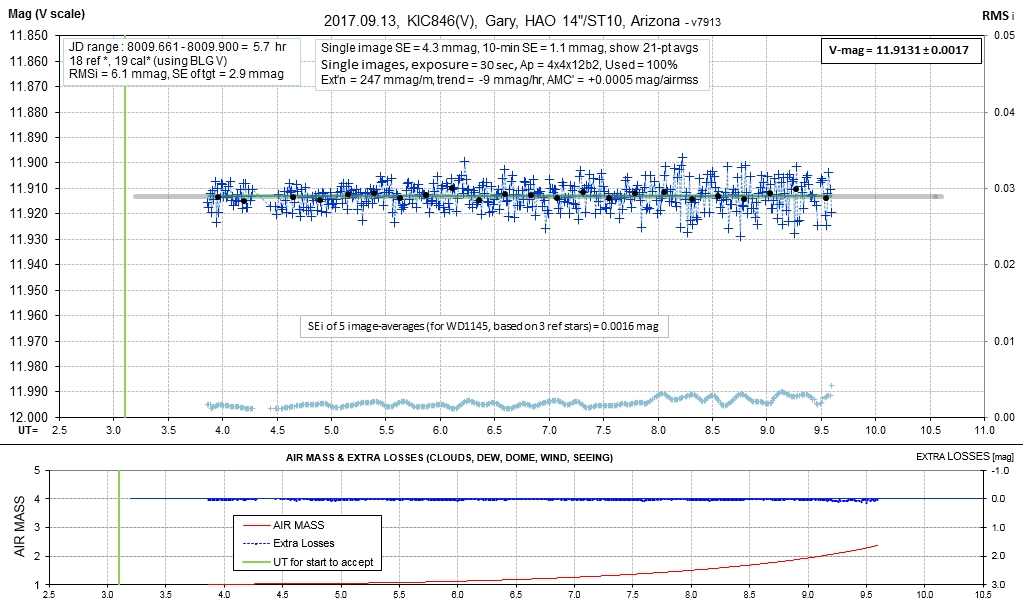
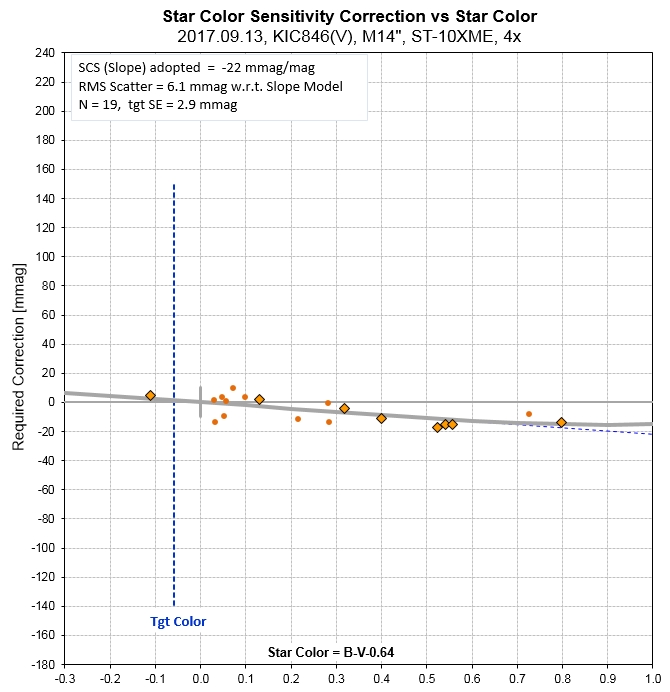
2017.09.12, V-band, 6.2 hrs DataExchangeFile
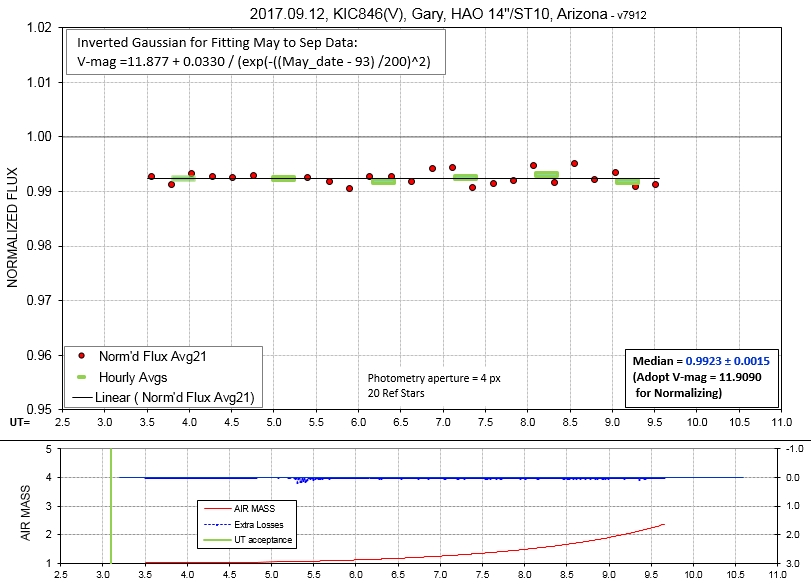
A slight increase, suggesting that egress (recovery) is
slowing.
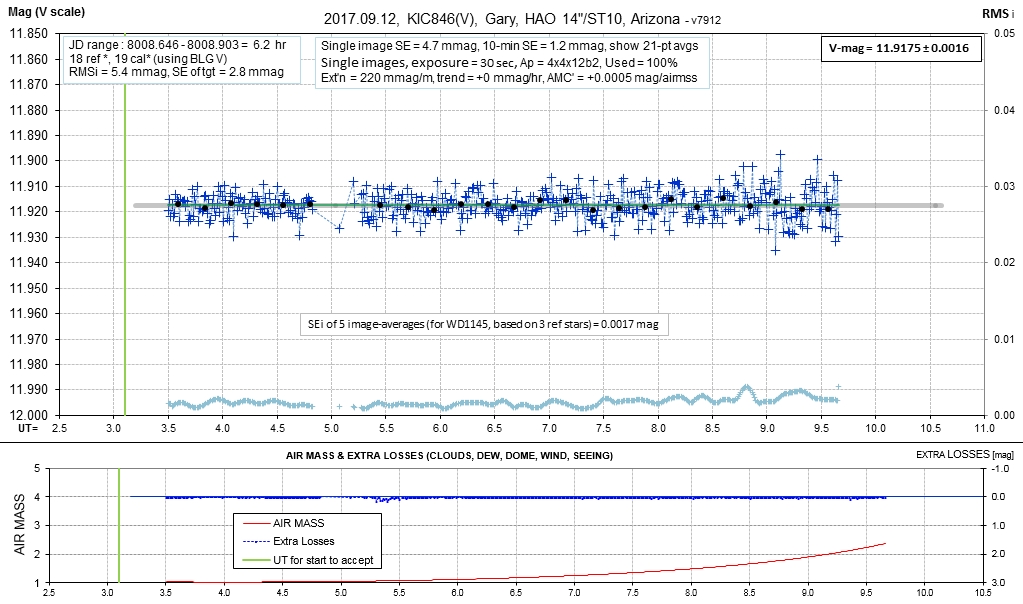
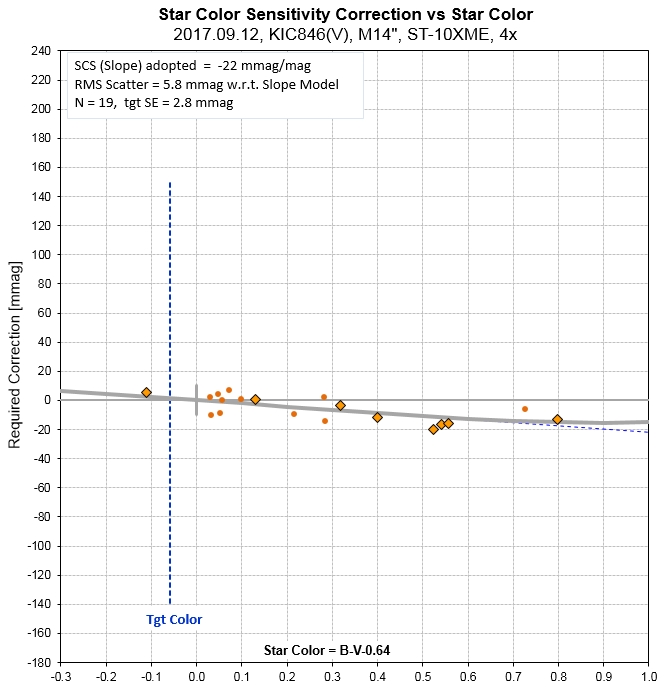
2017.09.11, V-band, 5.8 hrs
DataExchangeFile
This was the first night without "monsoon clouds"! It was clear
the entire night, which I haven't seen since June. Data quality is
therefore expected to be better than for the past 2.5 months.
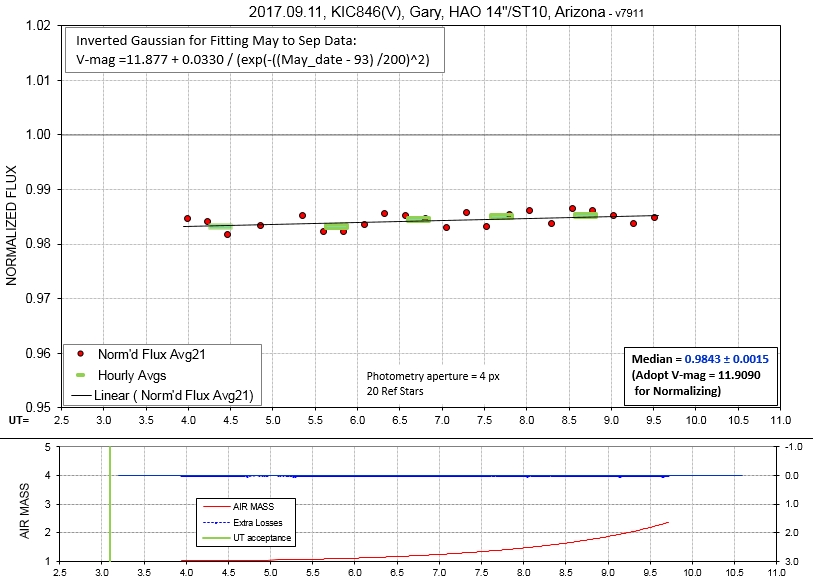
Notice the increase in brightness (normalized flux) during this
5.8-hour observing session.
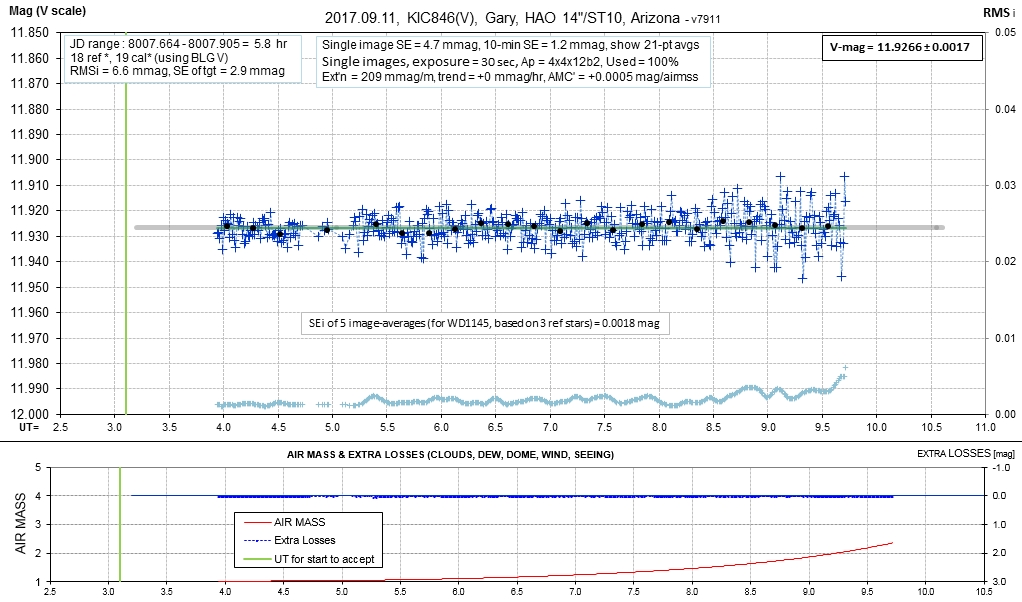
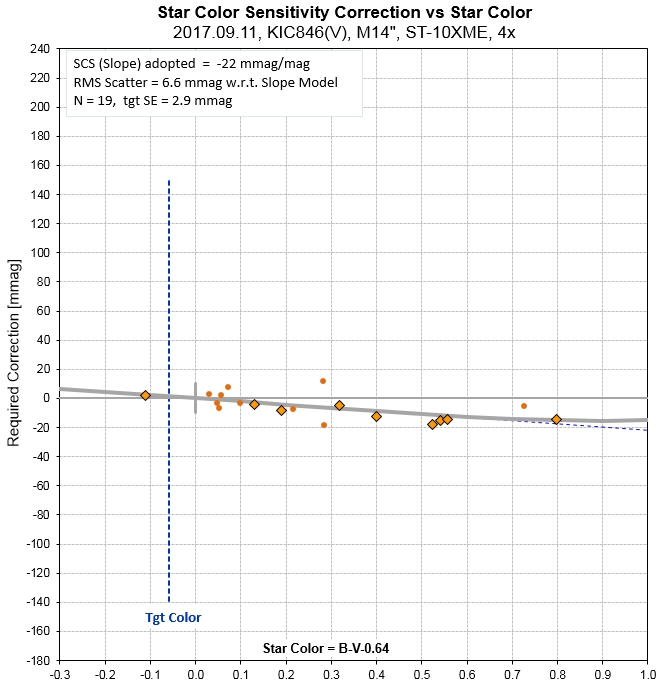
2017.09.10, V-band, 5.5 hrs DataExchangeFile
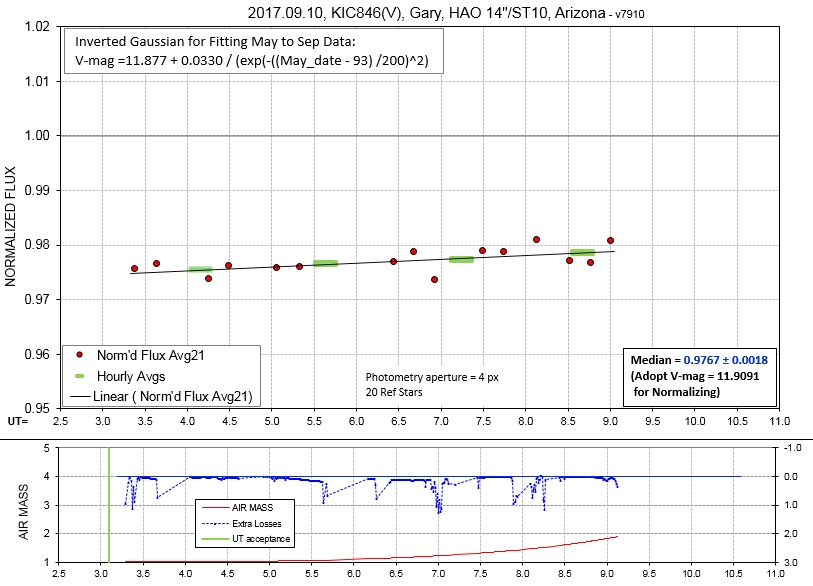
Looks like a recovery is underway.
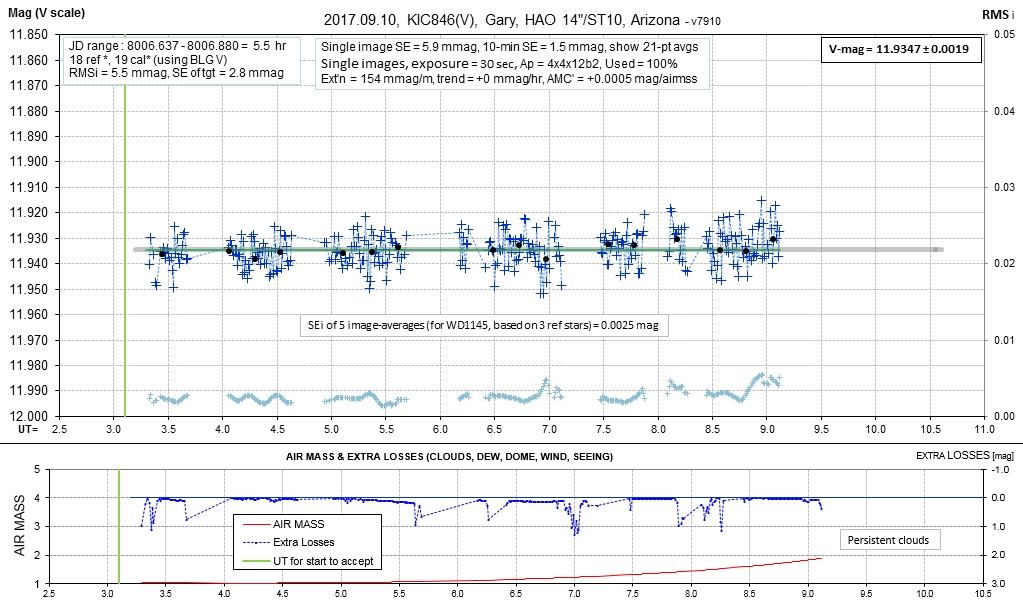
Darned clouds kept coming and going, which kept me awake much of
the night.
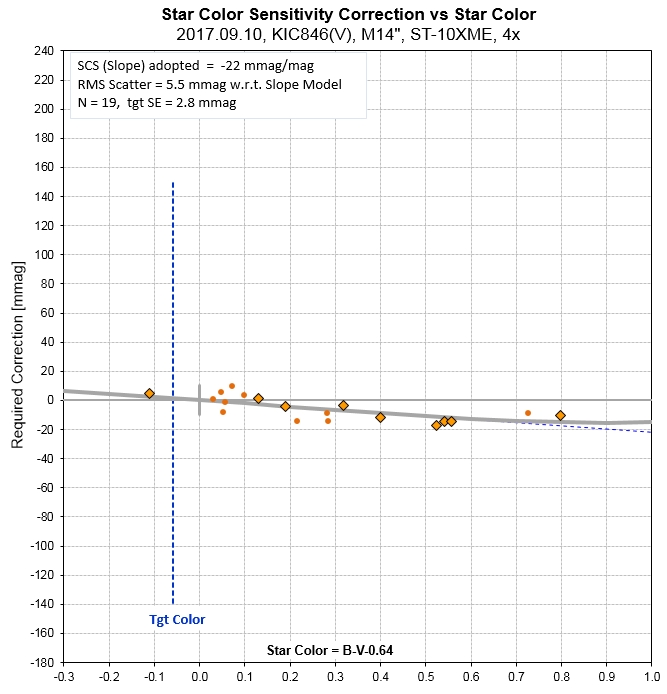
Good calibration!
2017.09.08, V-band, 1.9 hrs DataExchangeFile
Lot's of clouds, so I observed through holes.
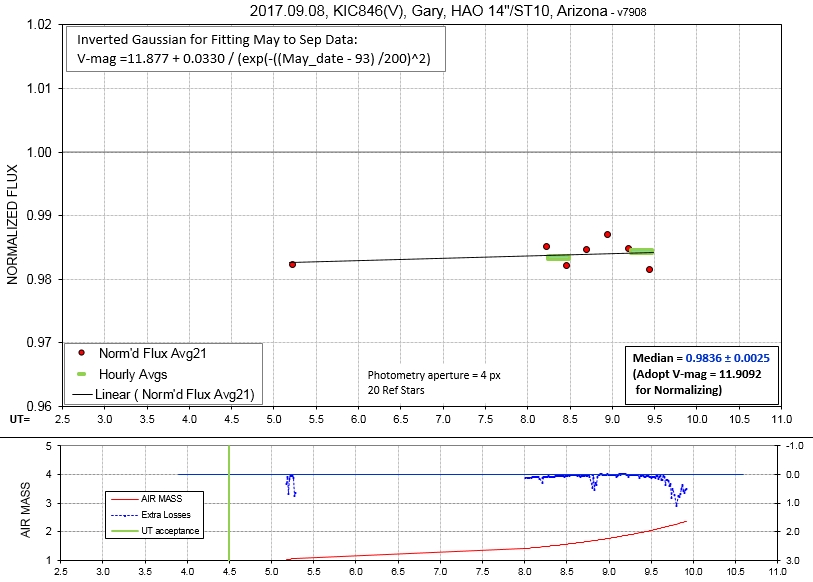
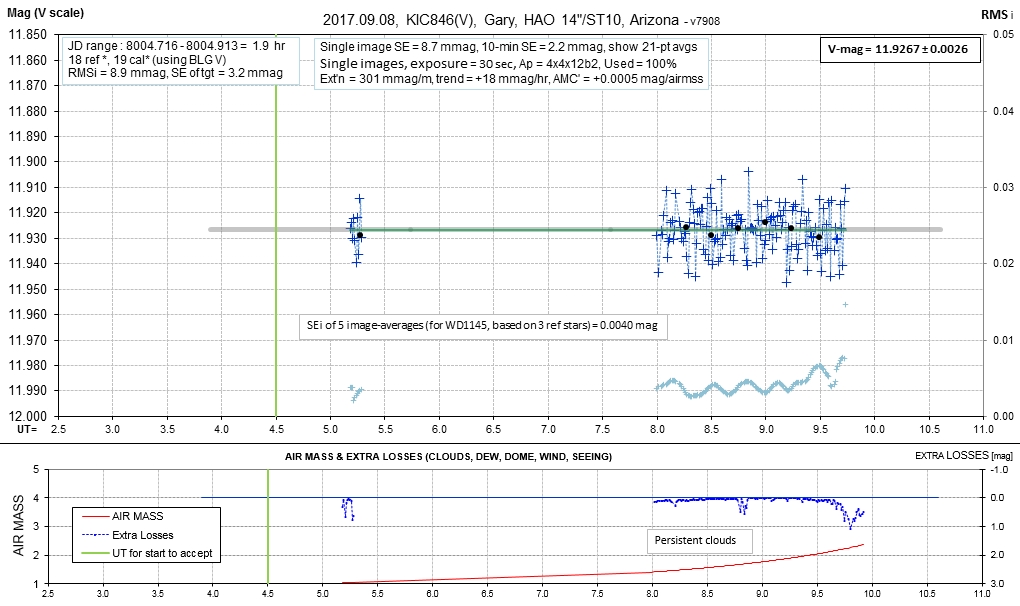
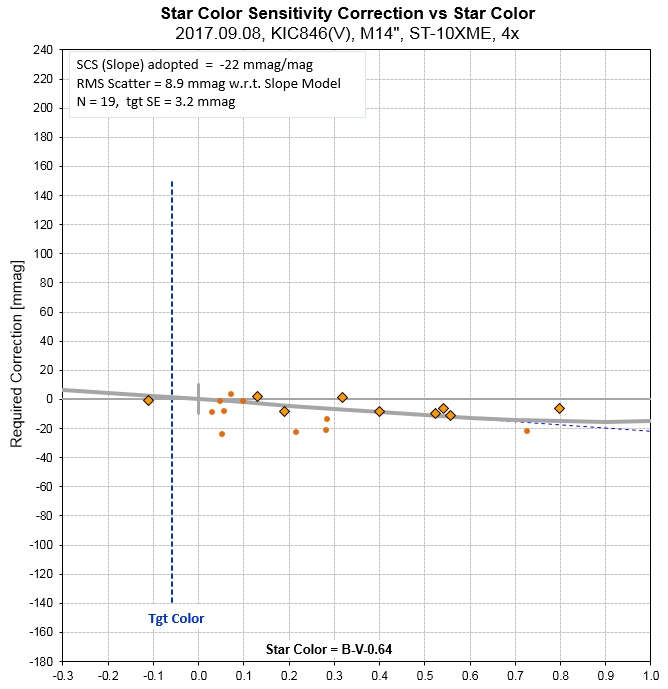
2017.09.07, V-band, 4.2 hrs DataExchangeFile
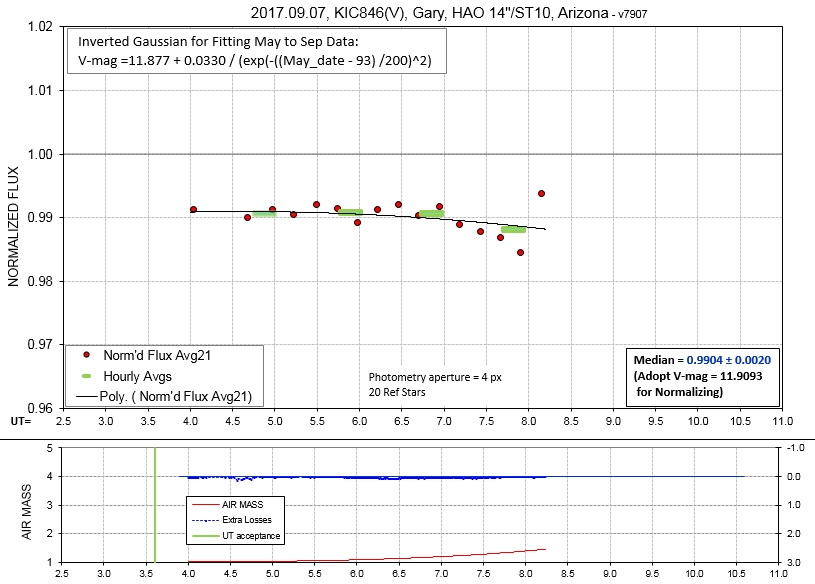
I wonder if the downward trend is real.
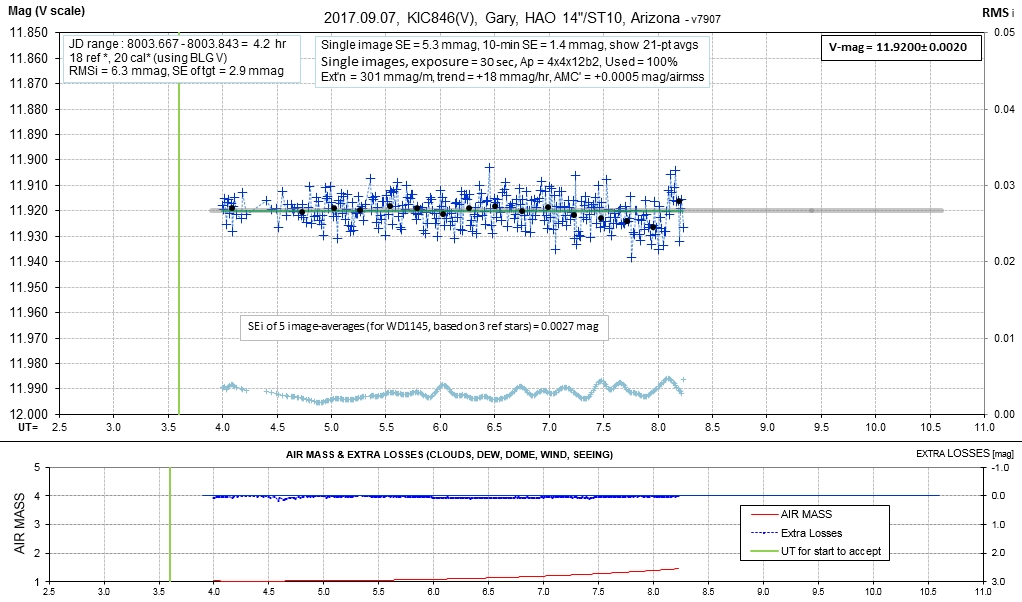
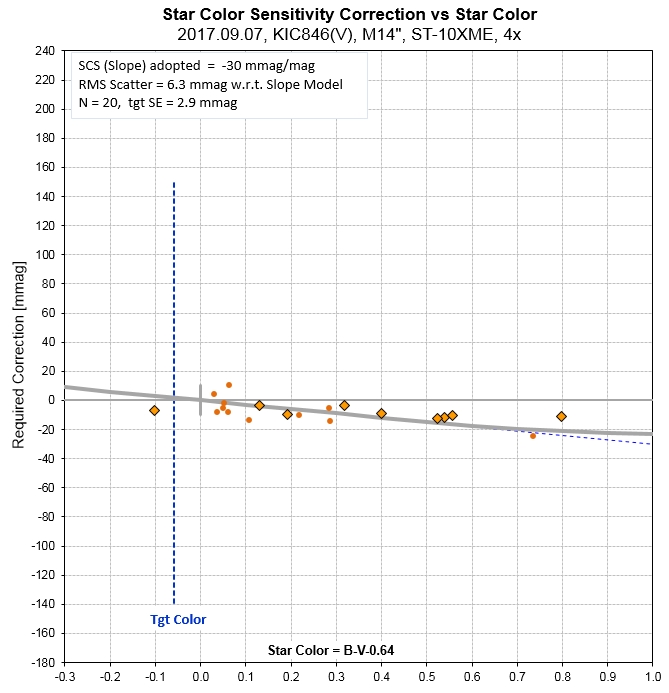
2017.09.06, V-band, 5.3 hrs DataExchangeFile
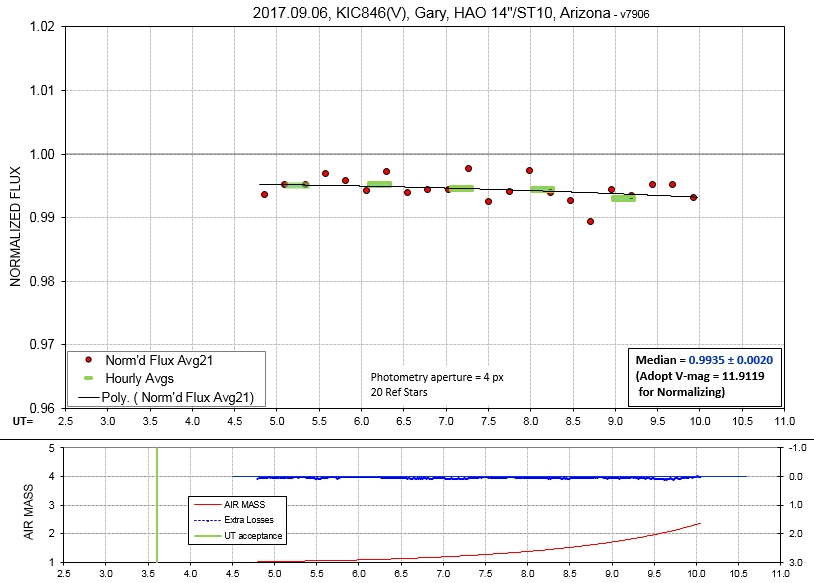
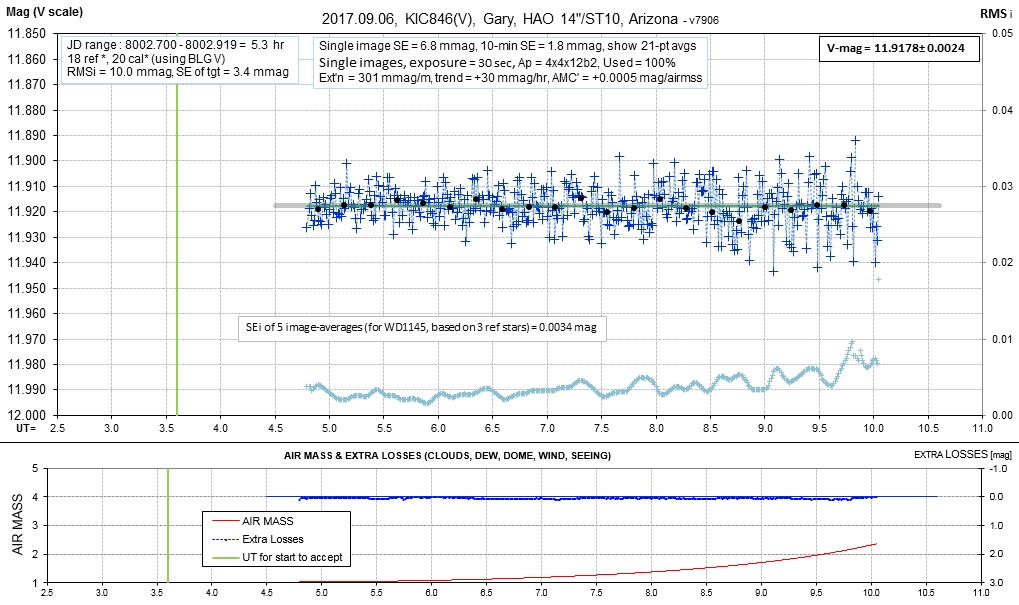
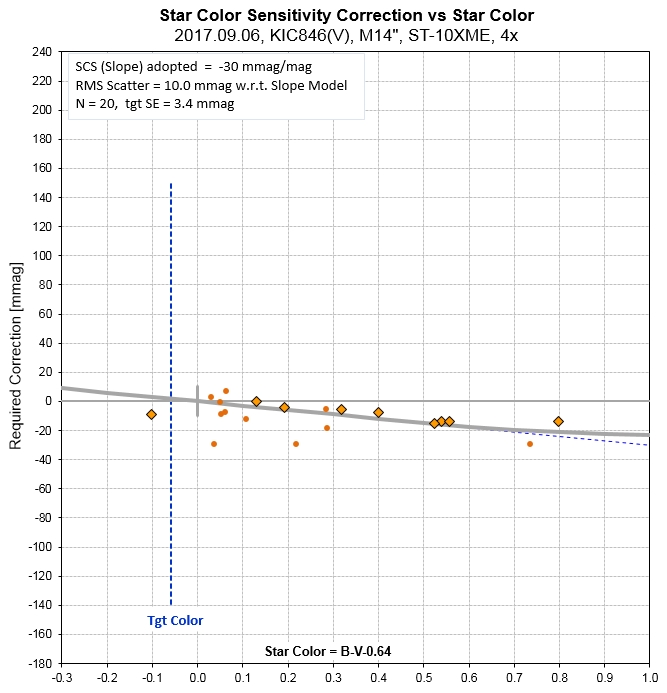
2017.09.05, V-band, 3.5 hrs
DataExchangeFile
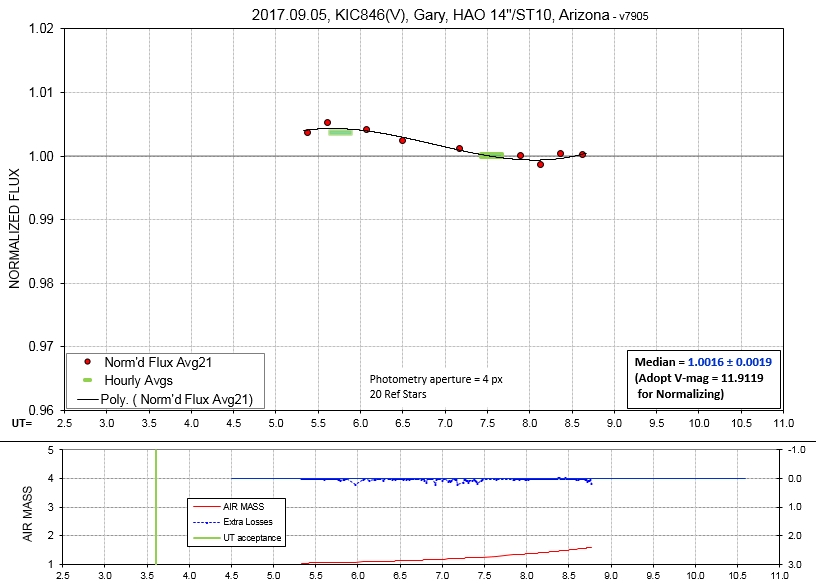
Note: This graph adopts the old nverse Gaussion model, which
doesn't account for the recent rise in OOT brightness.
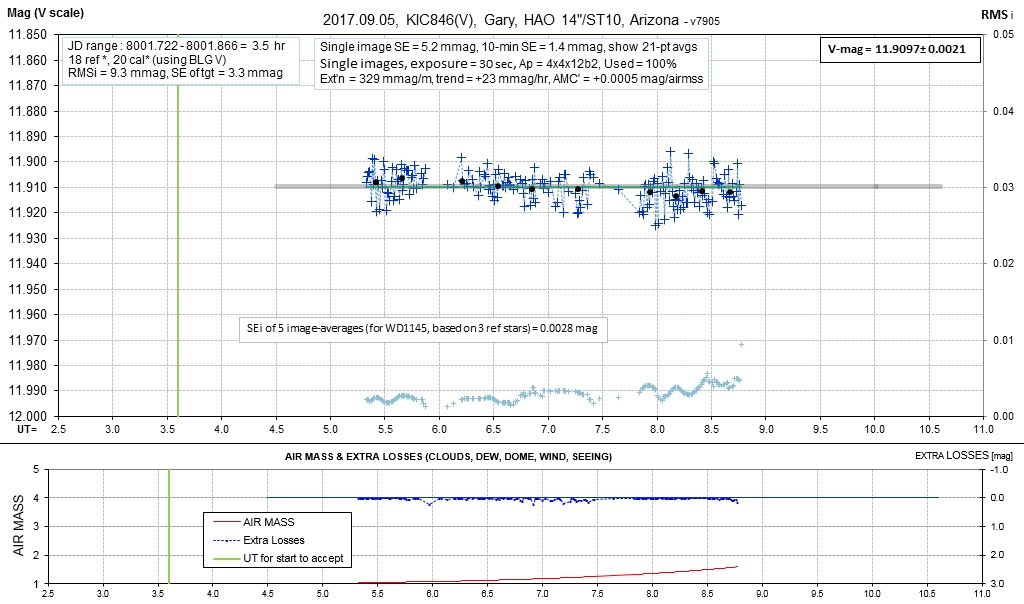
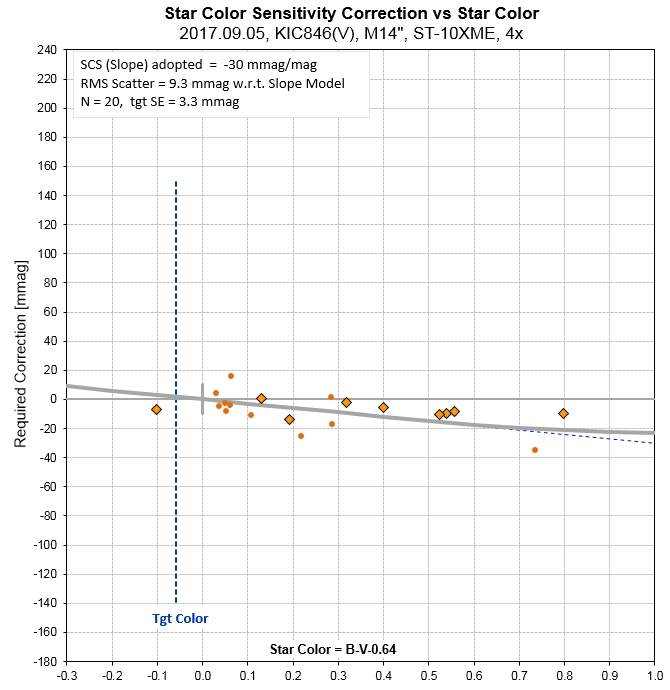
2017.09.03, V-band, 0.8 hr, DataExchangeFile
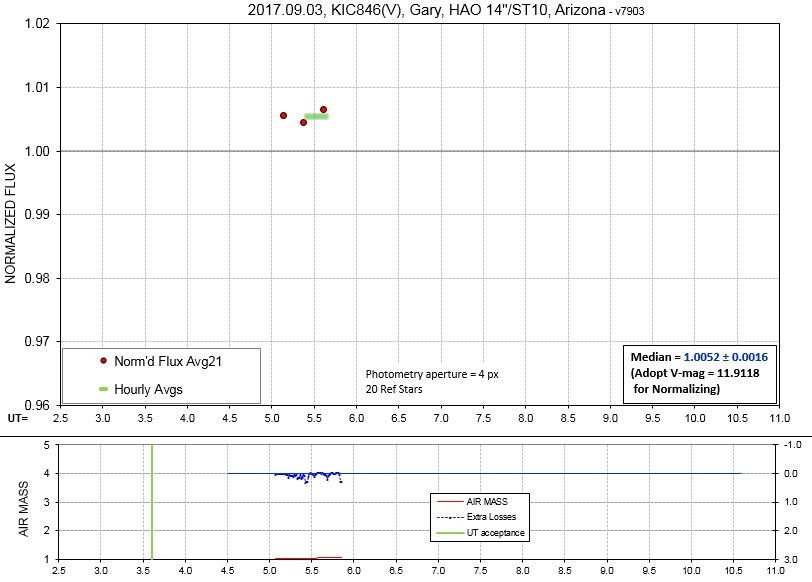
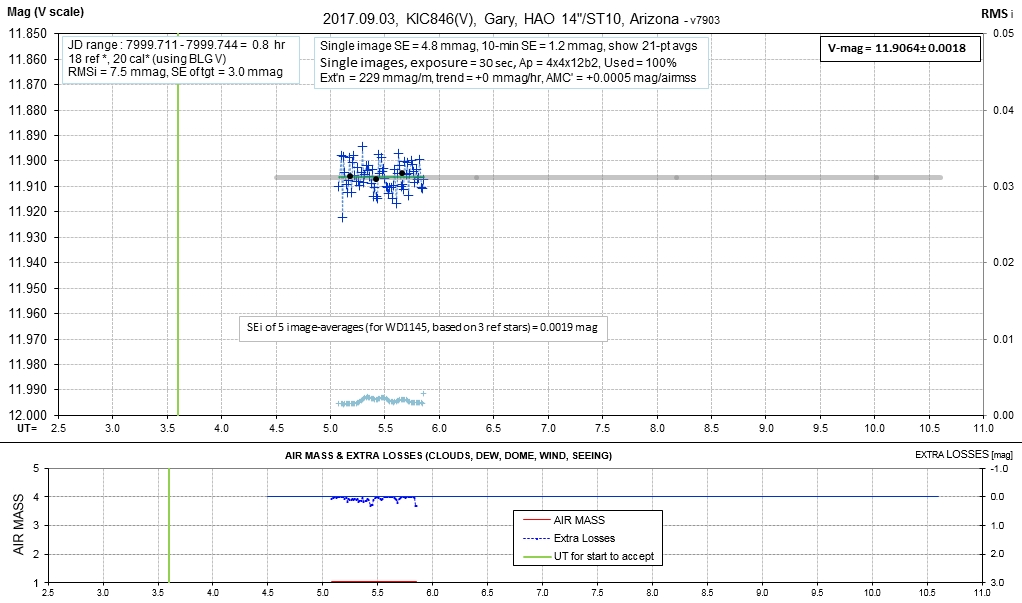
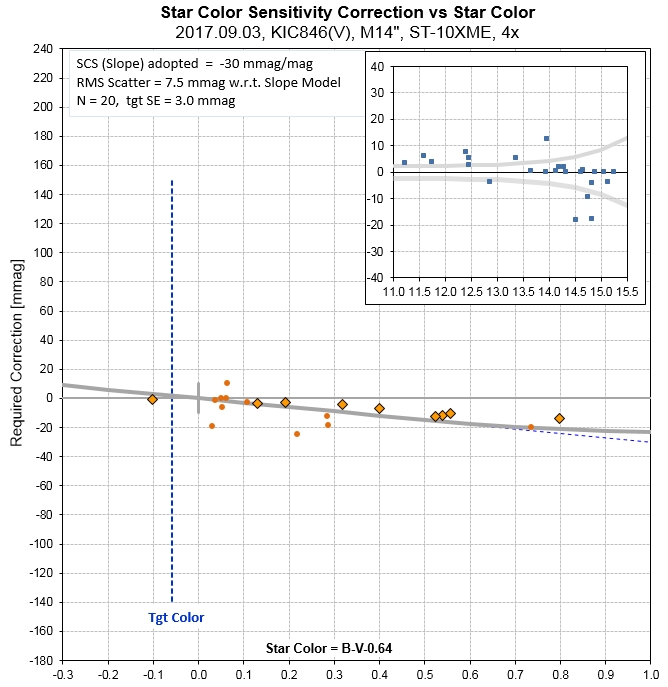
2017.09.01, V-band, 5.7 hrs
DataExchangeFile
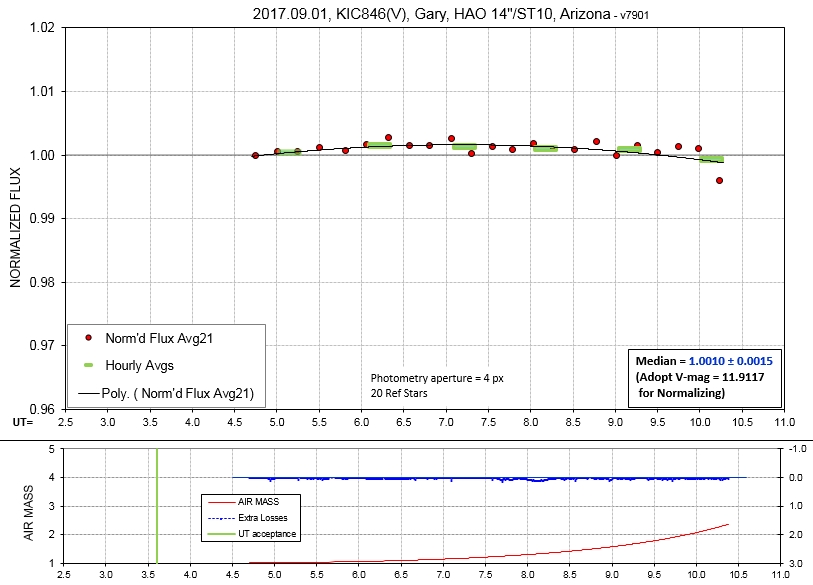
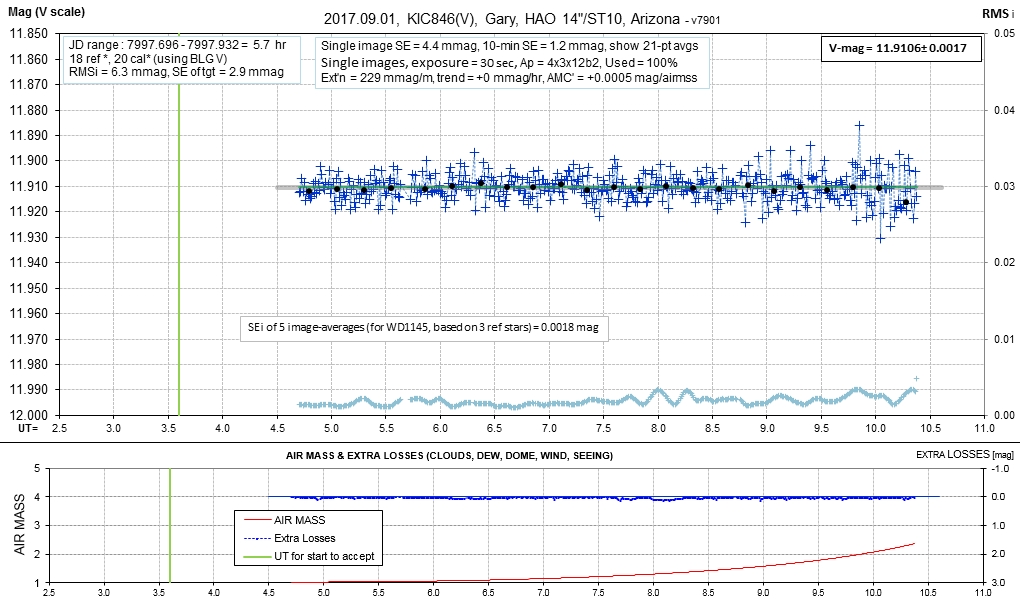
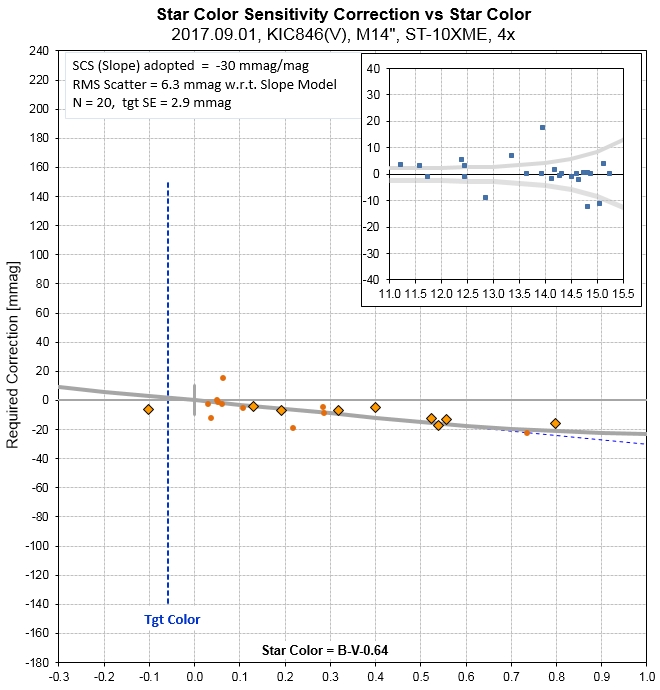
2017.08.31, V-band, 5.8 hrs DataExchangeFile
This is interesting: Tabby is seeing a fade (at r'-band) while I'm
seeing a brightening (V-band).
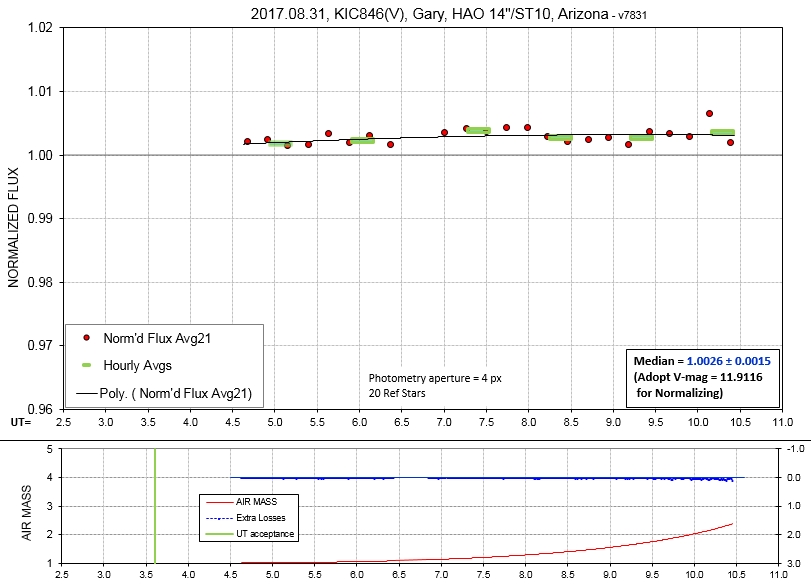
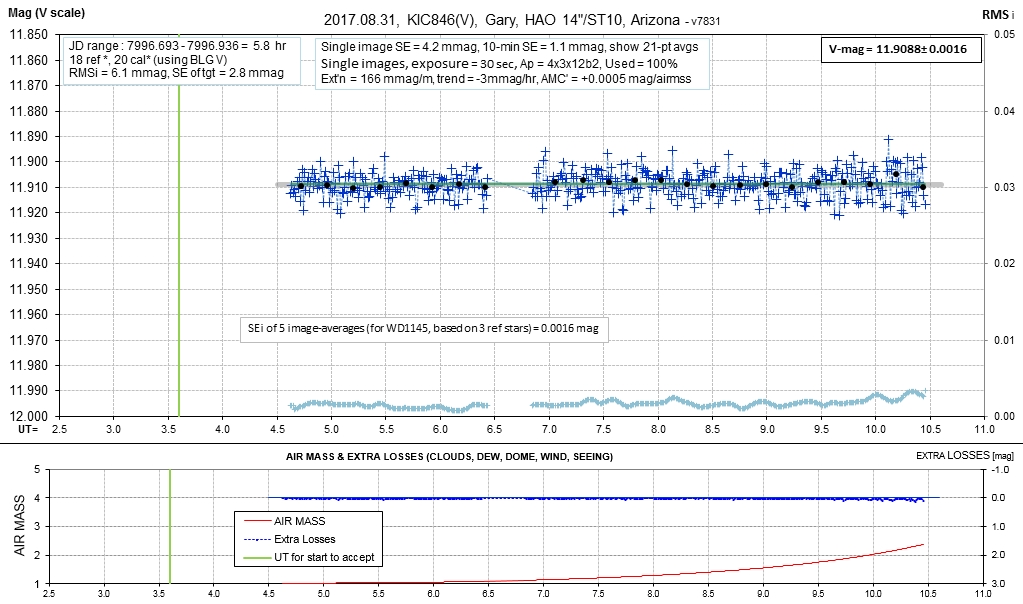
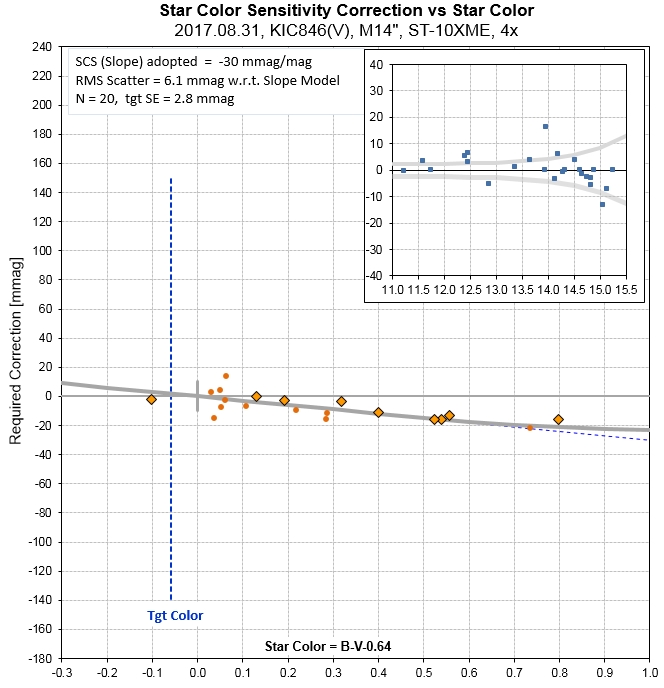
2017.08.30, V-band, 4.9 hrs, DataExchangeFile
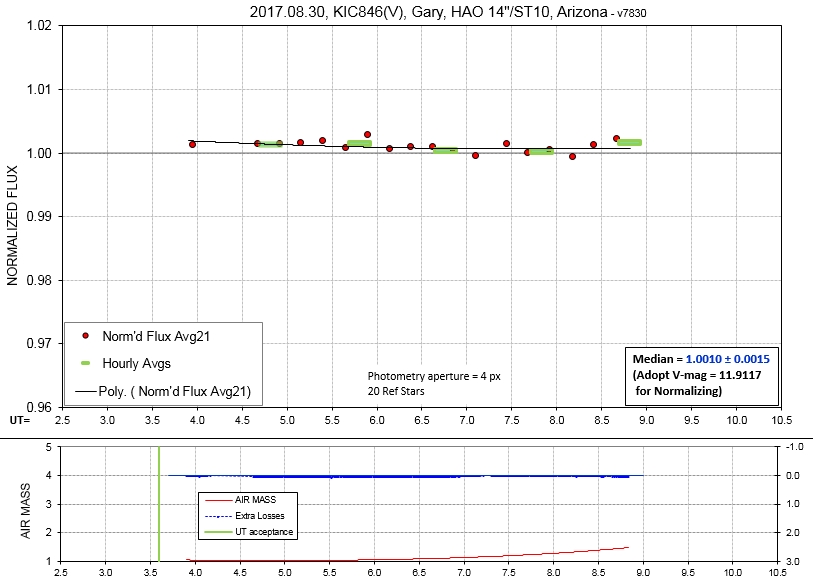
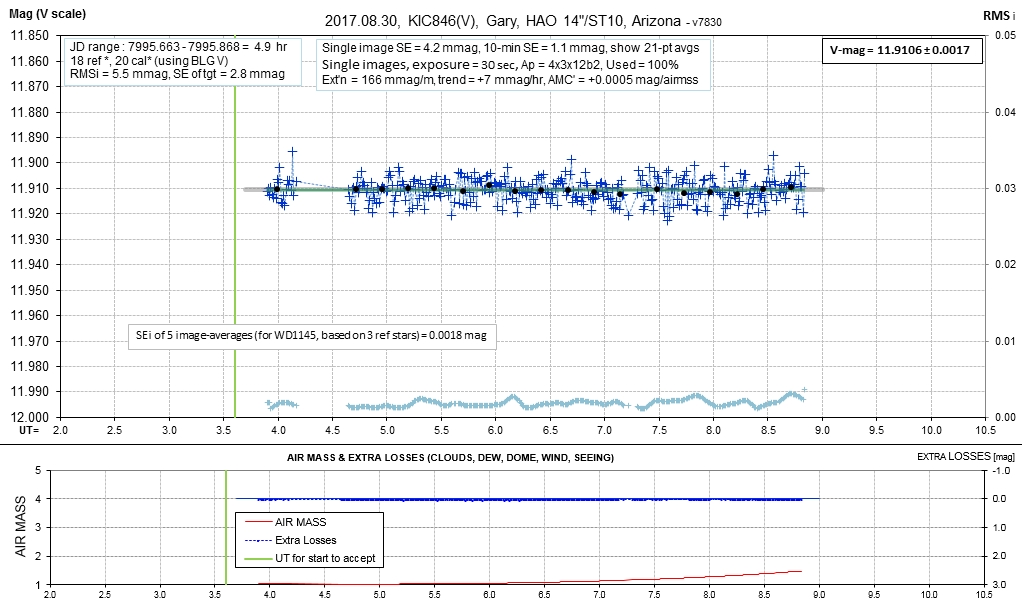
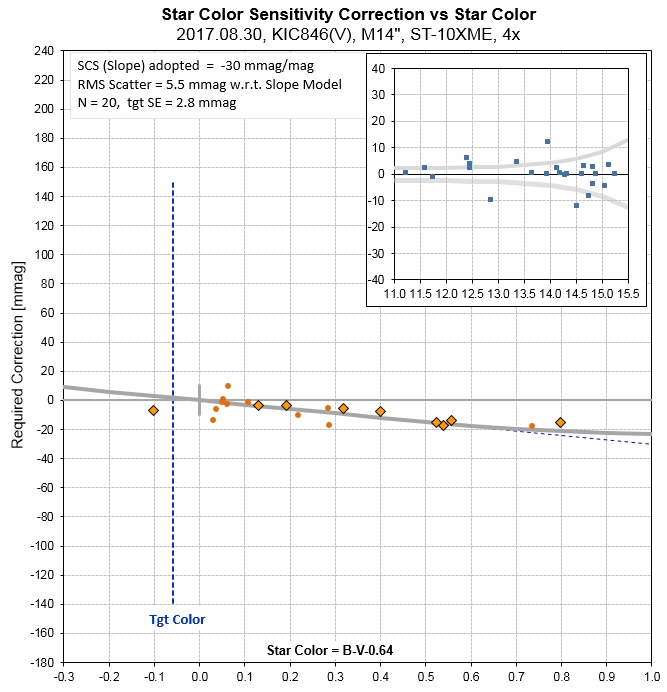
2017.08.29, V-band, 2.7 hrs
DataExchangeFile
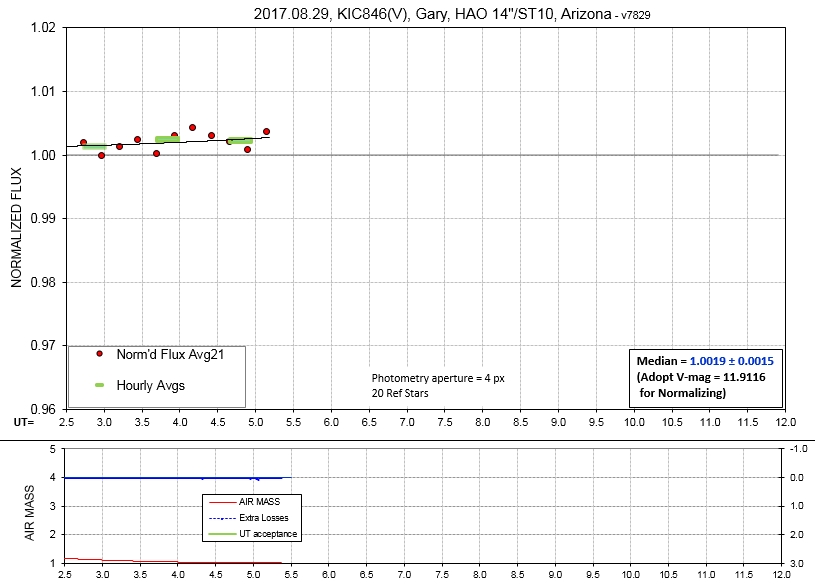
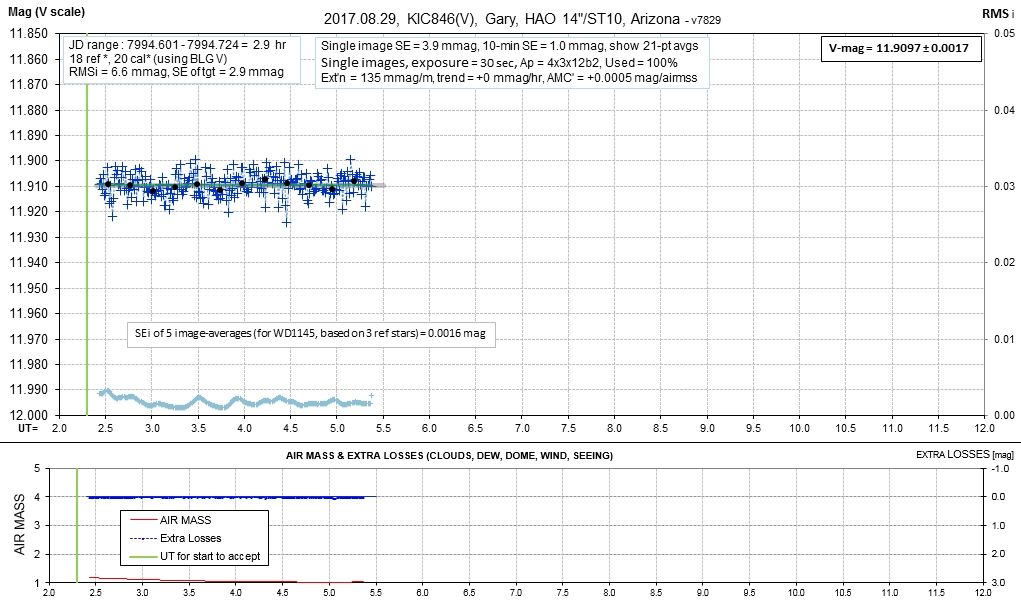
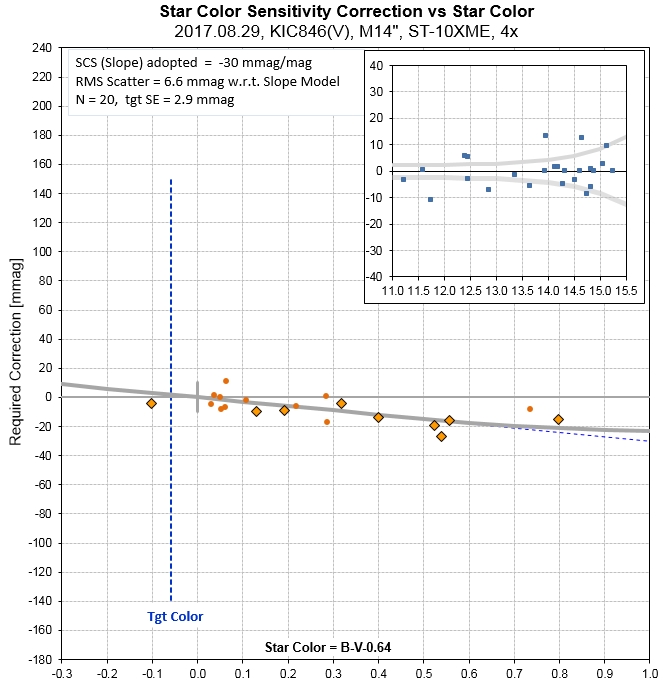
A
Prediction
I predict that in a matter of months the brightness of KIC846 will NOT plummet to zero, but
the level of interest in KIC846 by the general public will!
This will happen when the professional astronomers present
evidence that the fading events are produced by dust clouds, not
alien mega-structures. The hit rate for my KIC846 web pages, which
is currently about once a minute, will return to the once a month
level, just as they were for the 1.5 years before May 19 of this
year.
I have experience with the fickleness of such things based on my
2013 observations of Comet ISON - that so-called "Comet of the
Century." NASA bought into that terminology, possibly because it
garnered public interest in a project that NASA had funded. I was
the first to dampen enthusiasm when I made the first "recovery"
observation after a 2.5-month hiatus of imaging (due to the sun
being close to the line of sight) as the comet was making its
approach, and I stated that the comet was about a magnitude
fainter than models were predicting, and it might disappoint
during the rest of it's approach to perihelion. NASA continued to
hype the comet, and I attracted a fan club of cynics who trusted
my assessments and almost daily updates more than those by the
professionals. Some unscrupulous web hucksters took pictures from
my web site for posting on theirs with hyper-hysteric
interpretations; one posted a picture I had enhanced to show a
forward jet and on his web site he claimed to show a UFO flying in
formation ahead of the comet. As perihelion grew closer, and the
comet's brightness fluctuated at below expectations, and as my web
page hits grew to ever higher levels, and as experts were quoting
my kill-joy assessments, Discovery Channel scheduled an interview
with me at my observatory to coincide with perihelion passage. But
as the sun's heat sublimated the comet to nothing during closest
approach; public interest immediately plummeted to zero and the
the Discovery Channel interview was canceled. My web page hits
went to nothing, and my life returned to normal. But I was wiser,
for I finally understood the fickleness of public interest in
things scientific.
I predict that by the end September, when the evidence for dust
clouds and prosaic decadal variations are accepted, KIC846 will
join the "Hype of the Century Club" for being "the alien
mega-structure that wasn't."
References
Steele, I. A. & 4 others, 2017, "Optical
Polarimetry of KIC 8462852 in May-August 2017,"MNRAS (accepted), arXiv.
Simon, Joshua D., Benjamen J. Shappee and 6
others, "Where is the Flux Going? The Long-Term Photometric
Variability of Boyajian's Star," arXiv:1708.07822
Meng, Huan Y. A., G. Rieke and 12 others
(including Boyajian), "Extinction and the Dimming of KIC 8462852,"
arXiv: 1708.07556
Sucerquita, M., Alvarado-Montes, J.A. and two
others, "Anomalous Lightcurves of Young Tilted Exorings," arXiv: 1708.04600
Also: New Scientist link
and Universe Today link.
Rappaport, S., A. Vanderburg and 9 others,
"Likely Transiting Exocomets Detected by Kepler," arXiv:
1708.06069
Boyajian et al, 2015, MNRAS, "Planet Hunters
X. KIC 8462852 - Where's the flux?" link
Ballesteros, F. J., P. Arnalte-Mur, A.
Fernandez-Soto and V. J. Martinez, 2017, "KIC8462852: Will the
Trojans Return in 2011?", arXiv
Washington Post article, 2015.10.15: link
AAVSO Campaign
Notice requesting KIC646 observations
AAVSO LC Generator https://www.aavso.org/data/lcg
(enter KIC 8462852)
Web page tutorial: Tips for amateurs observating faint asteroids
(useful for any photometry observing)
Book: Exoplanet Observing for Amateurs,
Gary (2014): link
(useful for any photometry observing)
wikipedia
description of HAO
My web pages master list, resume
 B L G a r y at u m i c h dot e d u
Hereford Arizona
Observatory resume
B L G a r y at u m i c h dot e d u
Hereford Arizona
Observatory resume
This site opened: 2017.08.30. Nothing on this web page is copyrighted.























































 B L G a r y at u m i c h dot e d u
Hereford Arizona
Observatory resume
B L G a r y at u m i c h dot e d u
Hereford Arizona
Observatory resume